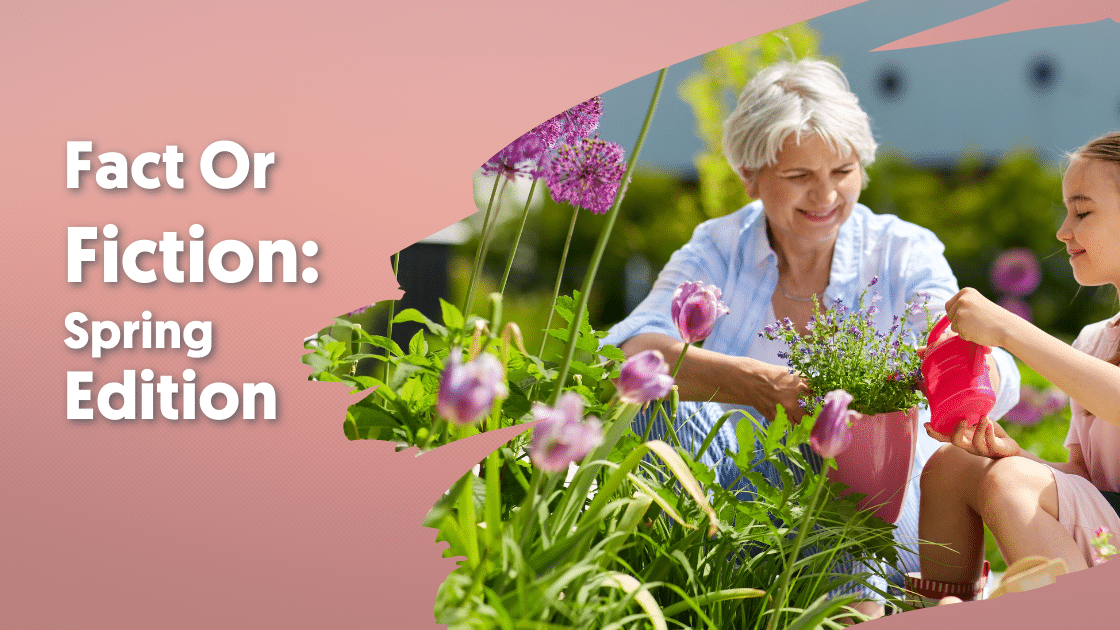It’s time to weigh in on some of the toughest trivia around with Fact Or Fiction Spring Edition. Sometimes the truth is stranger than fiction. Other times, tales handed down from generation to generation actually turn out to be completely fictitious! Put your knowledge to the test and see how much you know about the light and fresh season of spring.

#1. “April Showers Brings May Flowers” Is Really Based On Science.
The saying “April showers brings May flowers” is popular during the early stages of spring. This is especially true when the gloomy winter weather seems to be holding on for dear life. Oftentimes, people find themselves reciting these words as a prayer of sorts while simply hoping sunshine and warmer temperatures aren’t too far off. So, is this just a cute rhyme passed down to keep spirits high or is there more to it?
Fact Or Fiction? Click Here!
While this saying does in fact rhyme, it’s actually a reference to the real increase in rainfall that occurs annually, specifically in April. The uptick in precipitation leads to a resounding boom of blooming flowers sprouting up in May. Typically, the first spring flowers to make an appearance are lilacs, irises, lilies, tulips, daffodils and dandelions.This is fact.
#2. The North Pole Experiences 6 Months Of Darkness.
Without a doubt, life is a bit different at the North Pole. It’s located in the center of the northern hemisphere, right at the northern part of earth’s axis of rotation. As a result, the land experiences some pretty unique weather conditions. Each season has it’s own extreme, depending on which way the earth is tilted at that time of year. Does that mean springtime kicks off 6 months without sunlight in the North Pole?
Fact Or Fiction? Click Here!
On the first day of spring, the earth enters into the “vernal equinox”. This usually means the days and nights are equal, at 12 hours a piece. Those in the North Pole, however, start their 6 month stint leaning toward the sun. As a result, the people of the North Pole get a glimpse of the sun skimming the horizon, beginning six months of uninterrupted daylight at the beginning of spring. This is fiction.
#3. People Spend More Money During The Springtime.
In general, most people’s spending habits tend to go in waves. Whether it’s brought on by money-saving deals or simply a string of birthdays and other holidays in a row, some monthly credit card statements are worse than others. And while the holiday season is synonymous with shopping, there are plenty of other busy times throughout the year. But, does the warming spring months cause consumerism to skyrocket?
Fact Or Fiction? Click Here!
When seasons change, they affect more than just Mother Nature. In fact, most businesses and chambers of commerce have said daylight saving time is good for their bottom line. When this time shift was expanded from six to seven months, the grill and charcoal industries noticed that daylight saving brought them over $200 million in sales.This is fact.
#4. The Original Easter Bunny Had A Naughty And Nice List.
Every holiday has their own specific person or character that acts as a kind of mascot. Christmas has Santa Claus, Valentine’s Day has Cupid, St. Patrick’s Day has leprechauns, and Easter has the Easter Bunny. While all of these characters are unique to their respective holidays, their traditions and celebrations may have actually originated from a different holiday. So, was the Easter bunny the first to make a naughty and nice list, or has this tradition always belonged to Santa?
Fact Or Fiction? Click Here!
It probably comes as no surprise that the intention behind judging who has been naughty or nice was to make sure kids were well behaved during the holiday season. Legend has it, that the original Easter Bunny would carry colored eggs and candy, leaving the treats for nice kids and empty baskets for the naughty ones. The judgmental bunny also used to bring gifts to children the night before the holiday, just like Santa!This is fact.
#5. Daylight Saving Time Was Invented By Farmers.
When it comes to spring, getting a few extra hours of sunshine each night from daylight saving is arguably one of the best aspects. Over 70 countries take part in some form of daylight saving time, although their start and end times vary slightly. In the U.S., it lasts from 2 a.m. on the second Sunday in March until 2 a.m. of the first Sunday in November. The longer days are quite beneficial for many different industries, but were farmers the first to come up with the idea?
Fact Or Fiction? Click Here!
The flipside of having more light in the evening means there’s less in the morning. As a result, there’s far less visibility in those early hours for farmers trying to get their milk and harvest crops to market. Because of this, farm lobbies actually opposed daylight saving. The first person to introduce the concept of daylight saving was Benjamin Franklin in 1784. However, it wasn’t until 1895 when an entomologist named George Hudson proposed a “2 hour time shift that would give him more sunlight to go bug hunting” that a law was finally implemented.This is fiction.
#6. The Most Expensive Chocolate Easter Bunny Costs $10,000.
Undoubtedly, chocolate is extremely popular at Easter. In fact, there’s a chocolate egg in Italy that measures over 34 feet tall! That’s right. Weighing in at approximately 15,873 lbs, this chocolate egg is the largest in the world. But eggs aren’t the only shape of Easter themed chocolate, though. Chocolate bunnies are highly requested during the early spring months. It seems to reason that there’s probably an extravagant bunny shaped candy as well. So, exactly how much is the most expensive chocolate Easter bunny?
Fact Or Fiction? Click Here!
A pastry chef named Martin Chiffers was commissioned by a luxury British retail site to carve a one-of-a-kind chocolate masterpiece. The bunny statuette took 2 days to complete, measuring in at 15 inches tall and 11 pounds, about the weight of an average cat! More impressively, however, is the expensive detailing of the Easter candy creation. The 548,000 calorie edible animal features a pair of 1.07 carat solitaire diamond eyes. Valued at more than $37,320 for the eyes alone, the entire chocolate Easter bunny would set you back a whopping $49,000! This is fiction.
#7. Nearly 2 Billion Peeps Are Eaten Each Spring.
Did you know that it used to take over a <b>day</b> to make a single marshmallow Peep? 27 hours, to be exact. Back in 1953, the brightly colored sugar concoction was made by hand using a pastry tube. Luckily, modern technology dramatically improved the production process, now it only takes 6 minutes. With machines pumping out Peeps faster than ever, there’s no debate that the supply can keep up with the demand. Does that mean billions of Peeps are devoured during the Easter season?
Fact Or Fiction? Click Here!
Of course, Peeps are the most popular non-chocolate Easter candy, a rank they’ve held for more than 20 years. Every spring, more than 1.5 billion Peeps are purchased and consumed. Peeps are so popular, in fact, that in Bethlehem, Pennsylvania- where they originated- the locals drop a giant Peep on New Year’s Eve instead of a ball!This is fact.
#8. Easter Is The Top Candy-Consuming Holiday.
Easter and candy go hand-in-hand. Traditions passed down by generations involve handing out gift baskets, hunting candy-filled eggs, baking holiday treats, and not to mention all the bunny shaped chocolates. The amount of Easter related sugary delights that are available during the spring is nothing short of excessive. As a holiday with so many treats incorporated into the celebration, is Easter the reigning king of candy consumption?
Fact Or Fiction? Click Here!
Americans spends nearly $2 billion on Easter candy each year. Not only that, they consume over 16 million jelly beans alone. That’s enough jelly beans to circles the earth 3 times! As for the infamous Cadbury Creme Eggs, more than 1.5 million are produced every day in order to meet the demand. More impressively, the factory in Birmingham, England churns out 500 million cream-filled eggs each year. That’s enough eggs to create a tower taller than Mt. Everest! While all of this is quite remarkable, Easter still comes in second behind Halloween as the top candy holiday. This is fiction.
#9. Children Would Toss Eggs As An Easter Game.
When you’re a kid, Easter means one thing: Easter egg hunt. Often, eggs are filled with chocolatey candies, jellybeans, or more desirable treasures like stickers or even coins. Of course, the difficulty of the hunt all depends on the family. Some choose a leisurely fun route, while others try to make it as challenging as possible, deeming the winner worthy of that year’s title. While in this day and age everyone looks forward to the big hunt, did children play a different type of Easter egg game during the medieval times?
Fact Or Fiction? Click Here!
Can you even imagine throwing an egg in church? Well, that’s exactly what used to happen. Families would go to church Easter morning, like usual. However, instead of hiding eggs, the priest would throw a hardboiled egg over to one of the choir boys. He would then toss it to one of his peers, continuing until the clock struck noon. Whoever was left holding the egg at that time was declared the winner and got to keep the egg. This is fact.
Click here for more Fact Or Fiction trivia questions.



